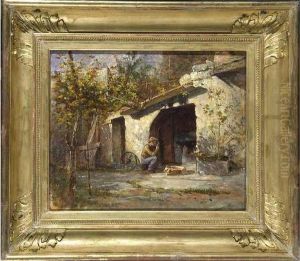Henri Blanc-Fontaine Paintings
Henri Blanc-Fontaine was a French painter born in 1819 in Lyon, France, and passed away in 1897. His artistic journey began in the vibrant cultural atmosphere of Lyon, a city known for its rich artistic heritage, particularly in textile design and fine arts. Blanc-Fontaine moved beyond the traditional boundaries of Lyon's artistic scene, venturing into the broader European art world, where he developed his unique style and thematic focus. He studied under influential teachers of his time, which significantly shaped his approach to painting, blending classical techniques with emerging trends of the 19th century.
Blanc-Fontaine's oeuvre is characterized by its versatility, spanning genres such as portrait painting, landscapes, and historical scenes. His work is noted for its meticulous attention to detail, vibrant color palette, and the ability to capture the emotional depth of his subjects. Despite facing the challenge of emerging artistic movements such as Impressionism, which shifted the focus of the art world, he maintained a commitment to realism and the classical traditions of painting. This adherence to traditional techniques did not prevent him from exploring the dynamic changes of his time, reflecting themes of industrialization and societal transformation in his work.
Throughout his career, Blanc-Fontaine exhibited his work at various prestigious venues, including the Paris Salon, where he gained recognition and accolades for his contributions to French art. His paintings were celebrated for their technical skill and emotional resonance, capturing the essence of the human spirit and the beauty of the natural world. Today, his work is preserved in museums and private collections, where it continues to be appreciated for its artistic merit and historical significance. Henri Blanc-Fontaine's legacy lives on as a testament to the enduring appeal of classical artistry in the face of a rapidly changing world.

